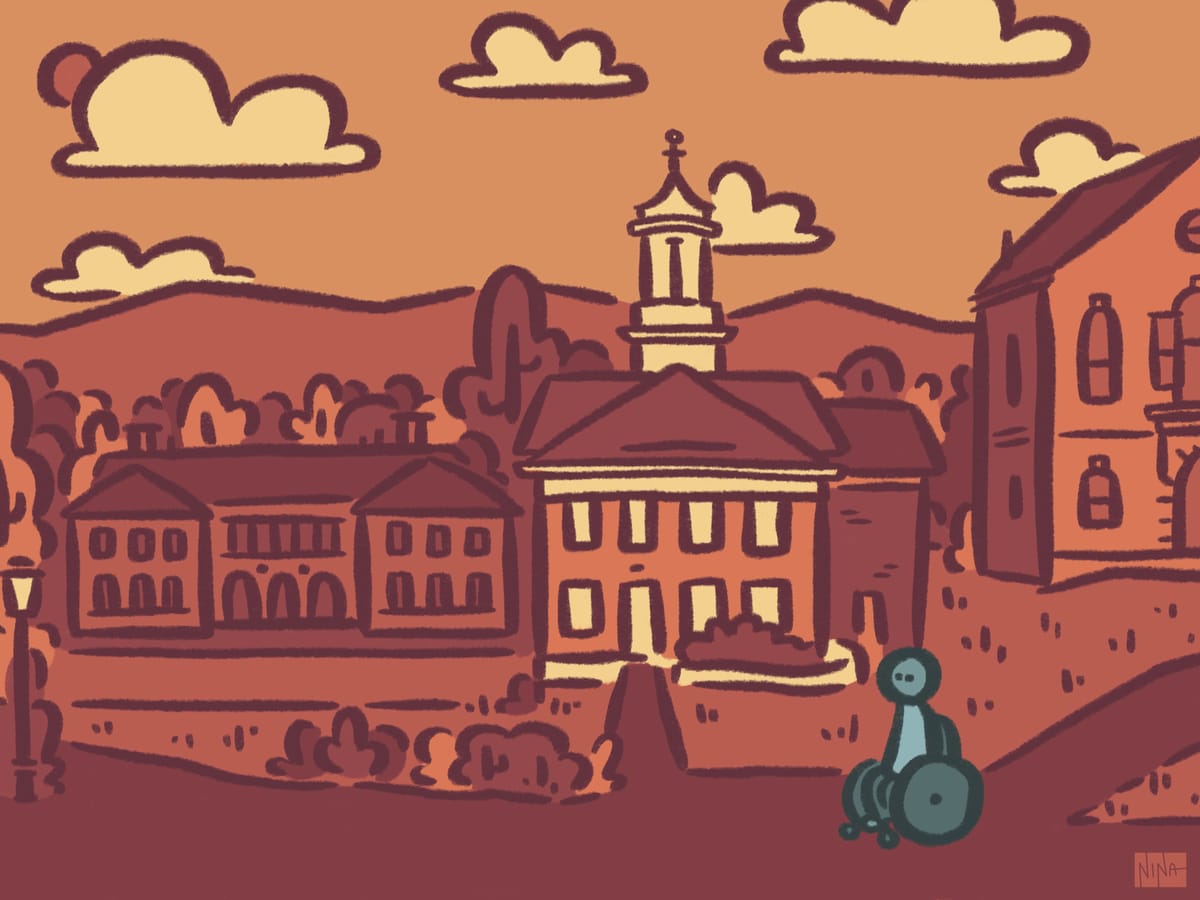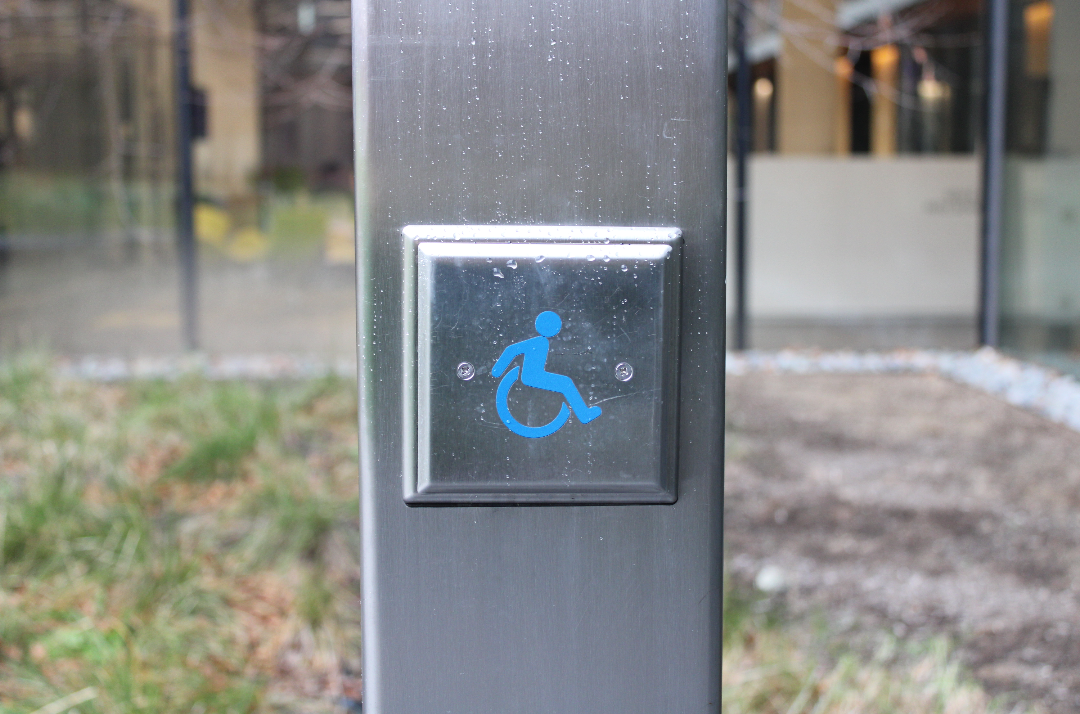Experiencing Ableism in Amherst’s Infrastructure
Willow Delp ’26 explores the difficulty of movement around campus, detailing experiences of disabled students as they face an institution characterized by physical and rhetorical hostility toward accessibility.

When I first came to Amherst this August, I was quickly submerged in the high-energy culture of orientation — the commotion, the activities, and the glee palpable in the late summer air. However, despite my excitement to be on campus and to be engulfed within its vibrant culture, there was something I quickly realized: Getting around campus could be exhausting.
The seemingly endless, sloping hills wore me out as I tried to keep up with the ambitious orientation schedule, jam-packed with countless activities under the sweltering sun. I found myself exhausted by the end of the day, my head spinning with new names and faces, and my legs groaning from running up that hill (without the glamor of a Kate Bush song.) As a person with chronic leg pain, the briefest walks feel infinitely longer during flare-ups, and since orientation I’ve sometimes had to limp while going from one building to another.
This campus, from my initial observations, seemed anything but accessible.
The many hills on the campus pose a challenge for students who have high blood pressure, asthma, chronic pain, or use a mobility device. Furthermore, many of the buildings on campus are very old, meaning they do not have to follow the requirements in the Americans with Disabilities Act of 1990 (ADA), which states that all buildings for public use must be “designed and constructed in such manner that the facility or part of the facility is readily accessible to and usable by individuals with disabilities, if the construction was commenced after January 26, 1992.” The far distance between some buildings on campus can also exacerbate existing issues, especially for new students unfamiliar with the campus layout.
Founded in response to these issues — and issues of accessibility for non-physical disabilities — the Disability and Neurodivergence Alliance (the DNA) is a student group that aims to acts as a site of community for disabled students, but also raises awareness towards existing accommodations that students can request, and works to establish positive relationships with faculty in pursuit of a more accessible campus. I learned about the group over the summer before I came to Amherst, and quickly became involved due to my passion for disability justice.

When I finally arrived, I was curious about the perspective of physically disabled students who have been at the school for years, and have had to deal with the mundane challenges of an inaccessibly-designed campus. I believe that the most well-versed in the disabled student experience are disabled students themselves, who have had to deal with the mundane challenges of an inaccessibly designed campus year after year. Their experiences on campus serve as testimony for the reality of Amherst College life.
Sam Hodges ’23, who serves as publicity director for the DNA, and also uses a cane and experiences joint pain, discussed the challenges of using elevators to get to classes.
Elevators “add a new level of complexity,” as Hodges says they are often tucked away in inconvenient locations. Many buildings don’t have directions for elevators, and the Keefe and Science Center elevators are especially slow. Floor plans are confusing and unclear, making it difficult for laypeople to determine what is an elevator versus an elevator storage area, further complicating an already difficult process. In some places, like the Loeb Center, the accessible entrance does not connect to an elevator that is student accessible.
To determine what is accessible, the campus utilizes a rubric for its campus map, available on the college website. Certain walkways cannot be designated as accessible due to the grade of their slope — a crucial challenge for the “college on the hill.” Pedestrian safety is another major concern, and an administrative priority. In my email exchange with director of accessibility strategy and resources Jodi Foley, she noted that “We carefully consider each recommended path based on safety first and convenience second.” Foley mentioned the college’s Facilities Accessibility Study Executive Summary, which outlines the college’s broader plans for increasing accessibility following its recently completed physical accessibility assessment, which “provided Amherst College with a blueprint for enhancing physical accessibility on campus.”
Many college buildings are exempt from modern accessibility policy under the ADA due to their age. The college is aware of this issue — its most recent Facilities Accessibility Study Executive Summary from 2019 specifically notes its aim to “expedite improvements to those facilities constructed prior to the passage of the Americans with Disabilities Act in 1990 that have not undergone major renovations since” (a category that includes many of the buildings on our nearly two-hundred-year-old, topographically unique, campus). But as Hodges lamented, “Do we have to rely on ADA technicalities?”
Book & Plow Farm and the Powerhouse have posed major challenges for Hodges, in terms of accessibility, due to their location. This is a troubling observation, considering the numerous campus social events hosted at these venues, making it more difficult for disabled students to engage with the community.
Tora Koh ’23, a senior with asthma and blood pressure issues, talked about how they struggled with the campus’ layout even before beginning their official tenure as an Amherst student. They participated in the Summer Bridge program as an incoming freshman, where they lived in Hitchcock Dormitory in the triangle and had a class in Webster Hall near Memorial Hill. They recounted struggling daily in a new environment with sleep deprivation, sunburn, and the aggressive summer heat, problems all exacerbated by their long walk to classes.

Since then, Koh’s challenges have continued. While they have been able to choose their classes in a way that maximizes ease, they haven’t been able to participate as fully in non-academic life. They need to be especially motivated to go to events hosted on the First Year Quad, and Johnson Chapel is out of the question due to its distance. In our conversation, they mentioned Mead Art Museum, saying: “It’s a super neat place and I would highly recommend it … I just can’t.” The administration has implemented a program called Mammoth Rides, an ACPD-run service to drive students around campus. Having used Mammoth Rides in the post, Hodges has voiced their concerns about the service – noting that it’s been difficult to identify which cars are the ACPD cars, and that students have had to wait outside in inclement weather.
Koh explained having to engage in a continual mental calculus to determine what Amherst activities they can participate in. This is the reason they live in Moore dormitory, to remain close to their many classes in the Science Center. “I’ve specifically had to go out of my way to position myself so that I’m not inconvenienced,” they said. With their singing lessons in the Arms Music Center, Koh has to walk up three flights of stairs and wait outside a classroom without benches.
Student experience like this shows the difficulties that all differently-constructed buildings on campus can pose. However, the facilities accessibility report notes that “the practicalities of funding and project management capacity dictate a phased approach” and so in improving accessibility in buildings on campus, they will prioritize “buildings that have not undergone major renovations since 1990 and that host unique programs or services not offered elsewhere on campus.”
Charlie Niedert ’25E, treasurer and social chair of the DNA, uses a wheelchair, and has faced issues with campus inaccessibility even before being physically present on campus. He informed Amherst of his disability after his initial acceptance and faced hostility from the administration.
Niedert said that “I have been told explicitly that this place was not meant for me …When I started my time here, I was very forcibly suggested to not come to campus and wait until I was healthier.” He explained that the infrastructure rendered the campus inaccessible for him, and that the systems in place have reinforced existing limitations.
Although Niedert was thankfully able to attend Amherst, he struggled with the lack of a disability community on campus in 2019 after his battle with obtaining accommodations. He expressed gratitude for the creation of the DNA. He said, “We have all these resource centers for so many different identities and marginalizations and yet there’s nothing really for disabled students, so I think that having [the DNA] will be beneficial.” The DNA is unique in that it’s grounded by lived student experience, a place in which the messy realities of disabled student life are mutually understood by all.
In his day-to-day life, Niedert noted, “going downhill is great, going uphill is not so great,” and cited his main obstacle as being slow elevators. He’s also had issues going to the Health Center, as people often park in a way that blocks the disabled entrance. This blocking of the accessible entrance was a constant before Covid. He has encountered barriers when trying to access campus resources, saying that there are “academic resources [he] simply cannot physically get to.”
The college’s report notes that as new renovation and construction projects begin, “the college intends to convene ad hoc committees of campus stakeholders to review the designs and provide essential practical insights regarding accessibility that will complement our compliance with applicable building codes.”
Niedert noted how intentional these efforts need to be. “Including disabled people requires a lot of active effort and change in infrastructure, and administrative and even teaching approaches. And I think they [the administration] prioritize[s] the idea of prestige and rigor over the inclusion of disabled people.”
For the future of accessibility at Amherst, I believe the most important principle to follow is the evergreen slogan used in the 20th century disability rights movement — “nothing about us without us.” When designing accessibility policy, disabled people must be at the forefront and present in all places where decisions are made.
In Amherst’s continuous quest for excellence, we cannot abandon disabled students. If we want to be a truly diverse, welcoming community, we have to interrogate all of campus life — including the very ground beneath our feet.
If you have thoughts on this or any of our articles, comment below or send us a letter by using this form or emailing astudent@amherst.edu.


Comments ()